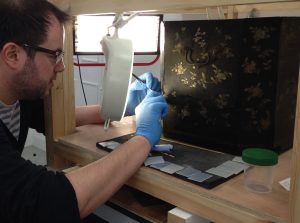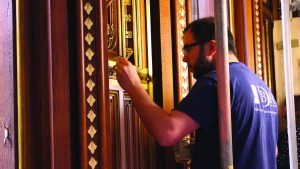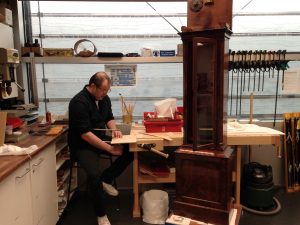Alex Owen graduated from our BA (Hons) Conservation Studies course in 2014. Here he tells us about his inspirational journey from Conservation Studies undergrad to Wooden Objects Conservator at the British Museum…
On my first day at City & Guilds I can remember feeling a little lost and incredibly curious. On campus you are always very aware that most of what City & Guilds does is teach the creative arts. I just remember wanting to spend time in historic stone and wood carving, in the wood shop, and the sculpture and fine art studios. Conservation felt like a complication – a behemoth of unknowns keeping me from exploring the labyrinthine site and getting to know all its inhabitants and learning about what they did.
From the outset I wanted to focus on Wood and Furniture conservation and was particularly interested in developing craft skills. However I soon developed a fascination with science spurred on by the practical way it is taught and applied at City & Guilds. I also paid full attention to anything the tutors would impart, from Pigments to History of Art, the Lime Cycle to the use of gels for cleaning. This gregarious approach to the diverse curriculum at City & Guilds has held me in good stead as it has allowed me to, for example, work as a stone conservator for Taylor Pearce between contracts at the Victoria and Albert museum’s Furniture Conservation Department.

In fact since graduating I’ve had to be very versatile. Among other roles I’ve worked as a stone conservator in private practice and as a furniture conservator in a museum environment as mentioned above, I’ve worked as a preventive conservator seconded to Westminster Abbey, and as a frames and gilded furniture conservator at a small private studio. I’ve taken on private conservation, gilding, and restoration work. I also busied myself with being on the committee, and ultimately chairing, the Icon Furniture and Wooden Object Group.

I am certain that this plurality of post-graduate experience played a large part in my being offered a permanent position as Wooden Objects Conservator at the British Museum, a dream job for me. However, I think the biggest single reason for my success was a placement at the V&A during my studies, facilitated by one of my tutors. The opportunity to work in a museum environment allowed me to prove myself in that immediate context. Then when temporary contracts came up at the V&A, I was a known and proven entity. Having then secured that experience, when applying for the position at the British Museum I was able to demonstrate an ability to deliver results at a large national museum.

Now I am beginning my career at the British Museum. I have been made section lead for Japanese and Korean objects with a focus on lacquer, and for large archaeological wooden objects. I also have responsibility for the Organics section’s machine tools and woodworking room. But what I really love about working here is the diversity of challenging objects we get to work on – my first object was a Haitian Voodoo drum!
MORE BLOGS
Frame and Furniture Conservation projects with Tutor Gerry Alabone
Historic Crafts: Gilding & Japanning
FIND OUT MORE
IMAGES
- Consolidating a C19th export lacquer tea caddy for my 3rd year practical project at City & Guilds
- Oil gilding in the Sovereign’s Robing Room at the Palace of Westminster.
- © The Trustees of the British Museum. Shared under a Creative Commons Attribution-NonCommercial-ShareAlike 4.0 International (CC BY-NC-SA 4.0) licence. Carrying out veneer replacements on a long case clock.


